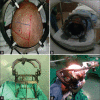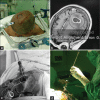Venture in 101 Cranial Punctures: A Comparative Study between Frame-based versus Frameless Biopsy of 101 Intracranial Space Occupying Lesion
- PMID: 30937031
- PMCID: PMC6417303
- DOI: 10.4103/ajns.AJNS_137_18
Venture in 101 Cranial Punctures: A Comparative Study between Frame-based versus Frameless Biopsy of 101 Intracranial Space Occupying Lesion
Abstract
Background: Presumptive diagnosis based solely on the clinical picture and imaging is not sufficient to provide appropriate treatment with certainty and hence histopathological confirmation of intracranial space occupying lesion (ICSOL) is essential. Needle biopsy via stereotactic frame-based or frameless neuronavigation technique is efficient procedure. The objective of this study is to compare their accuracy and efficacy and safety.
Methods: This is a retrospective comparative study conducted among 101 biopsies of ICSOL. Patients data were retrieved from medical record. Data were analyzed in SPSS ver. 20. P value of <0.05 was considered significant.
Results: Out of 101 patients, Frame-based stereotactic biopsy was done among 55 patients (54.4%) while 46 patients (45.6%) underwent frameless stealth neuronavigation guided biopsy. Male to female ration was 2.1:1. Age ranged from 5 to 82 years. 54.5% (55 patients) have deeper location of tumor while 45.5% (46 patients) have lobar location of tumor. Frontal (16.8%) and Thalamic (13.8%) were the common site. Mean size of tumor was 3.09±0.85cms. There was statistically significant difference in operative duration among study groups. Overall Diagnostic yield was 89.1%. Glioma was the most common (50.5%) diagnosis. Glioblastoma WHO Grade IV was 37.6% followed by lymphoma (12.8%).
Conclusion: Needle biopsy via stereotactic frame-based or neuronavigation frameless technique is a safe and efficient procedure having high diagnostic yield. Reasons for negative biopsy could be missed target or retrieval of gliotic tissue.
Keywords: Biopsy; accuracy; brain lesion; frame-based; frameless; neuronavigation.
Conflict of interest statement
There are no conflicts of interest.
Figures


References
-
- Conway LW. Stereotaxic diagnosis and treatment of intracranial tumors including an initial experience with cryosurgery for pinealomas. J Neurosurg. 1973;38:453–60. - PubMed
-
- Bernstein M, Parrent AG. Complications of CT-guided stereotactic biopsy of intra-axial brain lesions. J Neurosurg. 1994;81:165–8. - PubMed
-
- Dorward NL, Paleologos TS, Alberti O, Thomas DG. The advantages of frameless stereotactic biopsy over frame-based biopsy. Br J Neurosurg. 2002;16:110–8. - PubMed
-
- Horsly V, Clarke RH. The structure and function of cerebellum examined by a new method. Brain. 1908;31:45–124.
-
- Quiñones-Molina R, Alaminos A, Molina H, Muñoz J, López G, Alvarez L, et al. Computer-assisted CT-guided stereotactic biopsy and brachytherapy of brain tumors. Stereotact Funct Neurosurg. 1994;63:52–5. - PubMed

